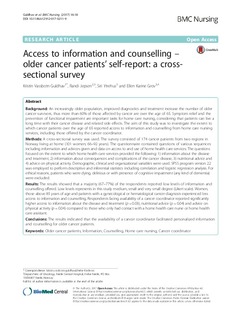| dc.contributor.author | Guldhav, Kristin Vassbotn | |
| dc.contributor.author | Jepsen, Randi | |
| dc.contributor.author | Ytrehus, Siri | |
| dc.contributor.author | Grov, Ellen Karine | |
| dc.date.accessioned | 2017-11-21T12:38:33Z | |
| dc.date.available | 2017-11-21T12:38:33Z | |
| dc.date.created | 2017-08-24T10:36:27Z | |
| dc.date.issued | 2017 | |
| dc.identifier.citation | Guldhav, K., Jepsen, R., Ytrehus, S., & Grov, E. (2017). Access to information and counselling – older cancer patients’ self-report: A cross-sectional survey. BMC Nursing, 16, BMC Nursing, 2017, Vol.16. | nb_NO |
| dc.identifier.issn | 1472-6955 | |
| dc.identifier.uri | http://hdl.handle.net/11250/2467350 | |
| dc.description.abstract | BACKGROUND:
An increasingly older population, improved diagnostics and treatment increase the number of older cancer survivors, thus more than 60% of those affected by cancer are over the age of 65. Symptom relief and the prevention of functional impairment are important tasks for home care nursing, considering that patients can live a long time with their cancer disease and related side effects. The aim of this study was to investigate the extent to which cancer patients over the age of 65 reported access to information and counselling from home care nursing services, including those offered by the cancer coordinator.
METHODS:
A cross-sectional survey was used. The survey consisted of 174 cancer patients from two regions in Norway living at home (101 women; 66-92 years). The questionnaire contained questions of various sequences including information and advices given and data on access to and use of home health care services. The questions focused on the extent to which home health care services provided the following: 1) information about the disease and treatment, 2) information about consequences and complications of the cancer disease, 3) nutritional advice and 4) advice on physical activity. Demographic, clinical and organizational variables were used. SPSS program version 22 was employed to perform descriptive and inferential statistics including correlation and logistic regression analysis. For ethical reasons, patients who were dying, delirious or with presence of cognitive impairment (any kind of dementia) were excluded.
RESULTS:
The results showed that a majority (67-77%) of the respondents reported low levels of information and counselling offered. Low levels represents in this study medium, small and very small degree (Likert scale). Women, those above 85 years of age and patients with a gynecological or hematological cancer diagnosis experienced less access to information and counselling. Respondents facing availability of a cancer coordinator reported significantly higher access to information about the disease and treatment (p = 0.03), nutritional advice (p = 0.04) and advice on physical activity (p = 0.04) compared to those who only had contact with a home health care nurse or home health care assistant.
CONCLUSIONS:
The results indicated that the availability of a cancer coordinator facilitated personalized information and counselling for older cancer patients. | nb_NO |
| dc.language.iso | eng | nb_NO |
| dc.rights | Navngivelse 4.0 Internasjonal | * |
| dc.rights.uri | http://creativecommons.org/licenses/by/4.0/deed.no | * |
| dc.subject | Cancer coordinator | nb_NO |
| dc.subject | Counselling | nb_NO |
| dc.subject | Home care nursing | nb_NO |
| dc.subject | Information | nb_NO |
| dc.subject | Older cancer patients | nb_NO |
| dc.title | Access to information and counselling - older cancer patients' self-report: A cross-sectional survey | nb_NO |
| dc.type | Journal article | nb_NO |
| dc.type | Peer reviewed | nb_NO |
| dc.description.version | publishedVersion | nb_NO |
| dc.source.volume | 16 | nb_NO |
| dc.source.journal | BMC Nursing | nb_NO |
| dc.source.issue | 1 | nb_NO |
| dc.identifier.doi | 10.1186/s12912-017-0211-9 | |
| dc.identifier.cristin | 1488311 | |
| cristin.unitcode | 216,10,0,0 | |
| cristin.unitname | Avdeling for helsefag | |
| cristin.ispublished | true | |
| cristin.fulltext | original | |
| cristin.qualitycode | 1 | |

